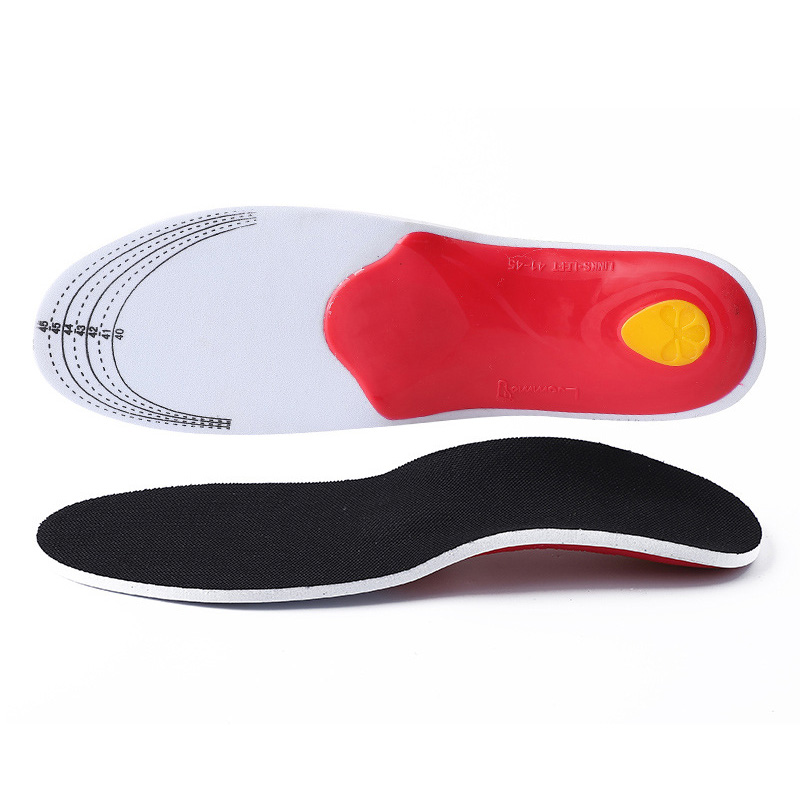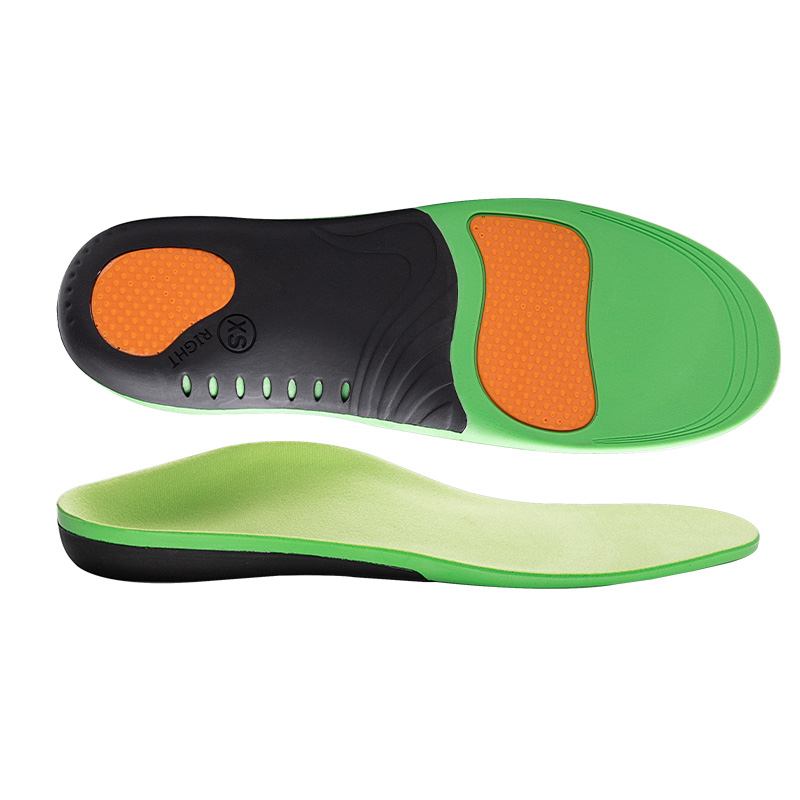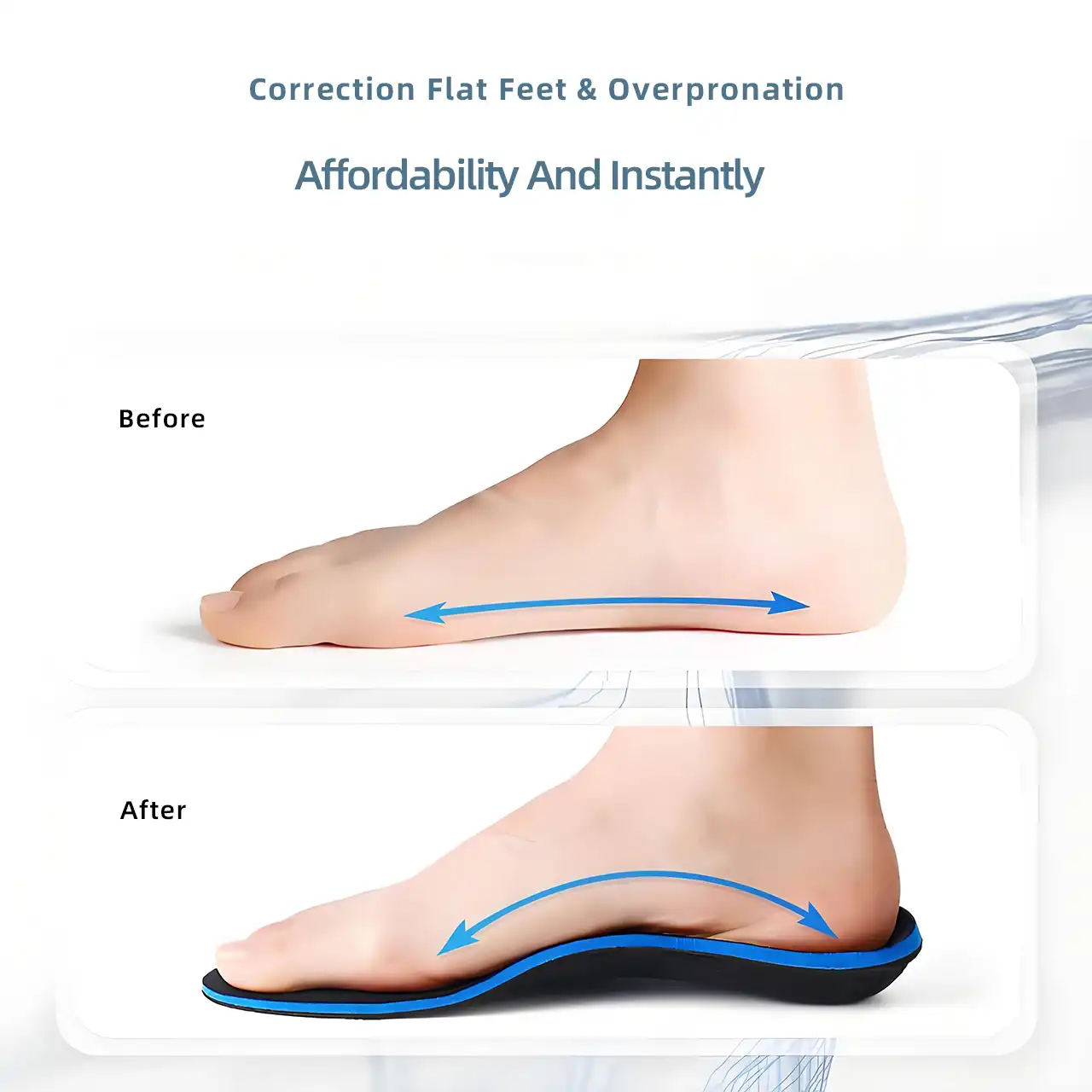Insoles for Flat Feet & Fallen Arches
Say goodbye to discomfort and hello to relief, designed to keep you moving with ease !
-
Sale!
 Select options This product has multiple variants. The options may be chosen on the product page
Select options This product has multiple variants. The options may be chosen on the product page -

RMF-006 Orthotic Insole For Flat feet
Rated 4.98 out of 5$29.71 – $34.63Select options This product has multiple variants. The options may be chosen on the product page -

RMF-013 Plus Size Orthotic Insole For Flat Feet
Rated 4.9 out of 5$31.15 – $66.91Select options This product has multiple variants. The options may be chosen on the product page
How Many People Have Flat Feet
Flat feet, a condition characterized by fallen arches, affect a significant portion of the global population. Estimates 20% to 30% of adults experience flat feet to varying degrees. With the world population nearing 8 billion, this translates to an estimated 1.2 billion adults living with this condition.
In the United States, studies indicate that around 8% of adults have flat feet. Given the U.S. population of approximately 335 million, this means that about 26 million Americans are affected. Flat feet are also prevalent among children, with estimates suggesting that about 15% of the pediatric population may experience this condition. Since children represent roughly 30% of the U.S. population, this could mean around 15 million children with flat feet.
Why You Should Buy Flat Feet Insole?
Using insoles specifically designed for flat feet offers several advantages. These benefits can significantly enhance daily comfort and support for individuals who experience fallen arches. From improved foot support to better alignment, insoles play a crucial role in overall foot health.
Improved Foot Support
Insoles for flat feet provide essential arch support, which is often lacking in standard footwear. This support helps distribute body weight evenly across the foot. When pressure is spread out, it reduces strain on the arches, which can feel weak or collapsed.
Insoles can also stabilize the foot during activities. This added stability can be particularly beneficial during walking, running, or standing for extended periods. As a result, users may find they can engage in these activities with less fatigue throughout the day.
Enhanced Comfort
Comfort is a major benefit of using insoles tailored for flat feet. These insoles are made from materials designed to cushion the foot while providing arch support. This combination can make shoes feel more pleasant to wear.
Many insoles include features like gel padding or memory foam. These materials add a layer of softness that absorbs shock during movement. Such enhancements help create a more enjoyable experience, especially for those who spend a lot of time on their feet.
Reduced Pain and Discomfort
One of the main issues people with flat feet face is pain,such as back pain. This discomfort can stem from the lack of support in regular shoes. By using specialized insoles, users may experience substantial relief.
The arch support from these insoles helps reduce pressure on specific areas of the foot. This relief can alleviate conditions like plantar fasciitis and general foot soreness. Consequently, many users report feeling less discomfort during daily activities, making life more manageable.
Better Alignment and Posture
Proper foot alignment is crucial for overall posture. Insoles for flat feet help maintain the foot’s natural position. By keeping the foot aligned, they also support the ankles and knees.
When the foot is aligned, it can positively affect the entire body. Good alignment can reduce the risk of injury and improve posture. This benefit extends to daily activities, like walking and standing, allowing for improved overall health.
What Are The Best Insoles For Flat Feet
Insoles designed for flat feet provide essential support and comfort. They help improve foot alignment and reduce pressure on the arches. Here are some top choices:
-
Roamingfeet Flat Feet Support Shoe Inserts
Great for athletic use. They offer strong arch support for running and activity. -
Powerstep Pinnacle Maxx Insoles
Recommended by podiatrists. These insoles provide excellent arch support without being too bulky. -
Timberland Pro Anti-Fatigue Technology Insoles
Ideal for work boots. They help reduce fatigue during long hours on your feet. -
ProFoot Flat Fix Orthotic
A budget-friendly option. These insoles are effective for mild flat feet at a low price. -
On My Feet All Day Orthotics
Made for all-day comfort. They are beneficial for those who stand or walk frequently.
Are Fallen Arches The Same As Flat Feet?
Fallen arches and flat feet are related, but they are not the same condition.
Flat feet is a term for the condition where the arches of the feet do not develop properly. This typically occurs during childhood and can be a genetic trait.
Fallen arches, or acquired flat feet, develop later in life. This can happen due to several factors, such as injury, aging, or specific conditions like posterior tibial tendon dysfunction.
Here are key differences:
| Feature | Flat Feet | Fallen Arches |
| Age of Onset | Usually starts in childhood | Develops in adulthood |
| Cause | Genetic or developmental | Injury, tendon dysfunction, or aging |
| Symptoms | Can be asymptomatic | May cause pain and discomfort |
Recognizing the difference helps in choosing the right insoles and treatment. Insoles designed for flat feet provide better support to help alleviate discomfort and improve mobility.
 Who Should Use Flat Feet Insoles?
Who Should Use Flat Feet Insoles?
Flat feet insoles are beneficial for various individuals. Here are some groups who may find them helpful:
People with Flat Feet: Those who have little to no arch benefit from added support. Insoles can help align the foot properly.
Individuals Experiencing Pain: Those suffering from foot, knee, or lower back pain may find relief. Proper support can reduce pressure on painful areas.
Athletes and Active Individuals: Runners and walkers may need extra support during activities. Insoles can improve comfort and performance, reducing fatigue.
Children with Flat Feet: Some children maintain flat feet into adulthood. Insoles can support developing feet and may prevent future issues.
Those with Specific Conditions: Individuals dealing with plantar fasciitis, shin splints, or other foot-related conditions may benefit from targeted support. Different insoles are designed for various issues.
Using the correct insoles can lead to more comfortable and healthier feet. It is essential to choose the right type for specific needs. Those unsure of what they need should consider consulting a healthcare professional. This ensures the right fit and support for their individual situation.
FAQs About Flat Feet and Fallen Arches Insoles
Many people have questions about flat feet and the best ways to manage discomfort. Here are some common inquiries and their answers to help individuals understand the impact of flat feet and how to find relief.
Can You Join The Military With Flat Feet
Flat feet can affect military eligibility. Each branch of the military has specific standards. Generally, mild cases of flat feet may not be disqualifying, but severe cases could impact performance and eligibility.
Are Barefoot Shoes Good For Flat Feet
Barefoot shoes can offer benefits for some with flat feet. They promote natural foot movement and strengthen muscles. However, they may lack the arch support needed for those with more severe flat feet.
Can wearing certain insoles improve discomfort from plantar fasciitis when you have flat feet?
Yes, wearing the right insoles can significantly reduce discomfort from plantar fasciitis. Insoles with good arch support help distribute weight evenly and relieve pressure on the heel and arch.
How can arch support insoles benefit those with flat feet and fallen arches?
Arch support insoles help by providing stability and preventing overpronation. This guidance reduces strain on muscles and ligaments, leading to less pain and improved posture.
Is Plantar Fasciitis Same As Flat Feet
Plantar fasciitis and flat feet are not the same. Flat feet refer to a foot structure where the arch is lowered. Plantar fasciitis is an inflammation condition affecting the tissue along the bottom of the foot, often linked to flat feet.
Does Flat Feet Make You Slower
Flat feet can impact running speed and agility. The lack of a proper arch may lead to instability, causing less efficient movement. This can result in slower performance in sports and other physical activities.
Can Flat Feet Cause Knee Pain
Yes, flat feet can lead to knee pain. They can change the way a person walks, putting extra stress on the knees. This may contribute to conditions such as patellofemoral pain syndrome.
Can Flat Feet Cause Shin Splints
Yes,Flat feet can contribute to shin splints by causing improper alignment of the legs during activity. This misalignment can lead to strain and discomfort along the shinbone.
How To Run With Flat Feet
To run with flat feet effectively, one should focus on strengthening the feet and ankles. Using supportive footwear and arch support insoles can also help maintain proper form during runs.
Do Flat Feet Cause Bunions
Yes,Flat feet may lead to bunions due to misalignment of the foot. When the foot’s structure is altered, it can increase pressure on the big toe joint, leading to the development of bunions over time.
Can I Get Disability For Flat Feet
Disability benefits for flat feet are possible, but it depends on the severity. If flat feet cause significant functional limitations and pain, individuals may qualify for assistance. A medical evaluation will be necessary to determine eligibility.


 Who Should Use Flat Feet Insoles?
Who Should Use Flat Feet Insoles?